General description of the shrub
An erect weigela bush grows up to 1.5 m in height. Some species can reach about 3 m. The shrub does not release lateral shoots underground, therefore it always has an original shape. On the bent branches, a huge number of elongated leaves grows, about 12 cm long. The edges of the plate are usually with small notches, the tip of the leaf is sharp. The color is traditionally green, although some species are purple or with a white border.
Inflorescences are tubular, resembling a small funnel. There are single variants and collected in original inflorescences.
On this topic:
There are different shades, namely:
- white;
- pink;
- purple;
- light purple;
- pinkish purple;
- red and purple.
The shoots strewn with inflorescences have a pleasant exquisite aroma that creates a unique aura at the summer cottage. A detailed description and photo of the weigela give a complete picture of the magnificent garden shrub for the summer cottage.
The shrub blooms in the last month of spring for almost a whole month. If weigela is properly looked after, you can admire the inflorescences at the end of August. Although there are not so many buds, the bush is still admirable. Flowers grow only on young branches of the current season. A picturesque picture of delicate bells against a background of lush greenery can be contemplated at the dacha during short autumn days. Autumn flowering is clearly visible in this photo of weigela, it is no worse than in summer.
Description of the weigela bush
There are about 15 species of this shrub, including hybrid plants. The main differences between different varieties are the height of the bush, the color and shape of the leaves, and the shade of the flower.
The general qualities and properties are preserved: the weigela flower is located on the branches singly or in groups, the bush blooms even before the foliage appears. A brief description of the shrub and its species will help gardeners choose the plant that is most suitable for the site.
Weigela varieties
Weigela early
The most common in the middle latitudes is weigela early or pleasant.
- The height of this species is about two meters, the bush has the shape of a ball.
- The spiky green leaves tilt slightly downward, and the bright pink flowers sprinkle the branches of the plant.
Sometimes the color of the flower has a white color in the core with yellow blotches, and towards the end of the petal, the color changes to pink. In this case, you should not worry - the bush is healthy, this color is only a specific feature.
Inflorescences have two or three flowers. The first flowers appear at the end of May.
You can enjoy the view of blooming weigela until about mid-June, the total flowering time ranges from 10 days to a month, the care of the plant and environmental conditions have a direct impact.
Weigela Variegata
A variety of this variety is weigela variegata.
The shrub is distinguished by the color of its foliage. The leaves have a lime green hue, covered with yellow blotches that turn white with the onset of summer.
Weigela blooming or Florida
The tallest shrub, its height reaches three meters
The bright pink shade of the inflorescences instantly attracts attention. Flowers are arranged in small groups on a branch.
Flowering begins in late spring and lasts until mid-June.
Weigela Nana Purpurea
Grows up to 150 centimeters. The bush has a spherical crown and a large number of leaves, casting a brownish-burgundy hue. The pink funnel-shaped buds have a yellow core inside. The flowering period of the shrub ranges from June to July.
Weigela Alba
Weigela Alba shrub has a small growth.It differs from its counterparts in the peculiarity of flowering: over time, white flowers take on a pink tint.
Weigela Victoria
The variety called Victoria is beautiful and bright, visually stands out on the site. The small size of the plant (about one meter) is compensated by rich red flowers and brownish leaves.
Weigela hybrid varieties
Weigela hybrid varieties stand out separately.
- They are distinguished by a dense crown of shrubs and a large number of flowers on the branches.
- The average plant size is about one and a half meters.
- The flowers are arranged on the branches one by one or stray into small groups, the shape of the flowers resembles a funnel.
Color shades can be varied.
Weigela pink, white, red and purple shades can be located on the site.
Bristol Ruby, Red Prince, Middendorf are in special demand.
Let's consider these types in more detail.
Bristol Ruby is a tall and spreading three-meter bush with leaves of a deep green hue.
The color of the flowers is uneven, the core has an orange tint, the petals turn from pale to a more saturated pink. The shrub quickly takes root on the site, at the end of June it begins to bloom.
Weigela Japanese is a miniature and thermophilic variety. The height of the bush rarely reaches more than one meter. The inflorescences consist of three copies, the buds have a deep red color.
The Korean plant variety is a one and a half meter wide bush. Smooth, bright green leaves have a fleecy surface on the inside.
The attractiveness of the variety for gardeners is achieved due to the beautiful and large flowers, the size of which often reaches 4 centimeters.
During flowering, funnel-shaped buds change color from light pink to sanguine red.
Popular types
There are the following types of weigela:
- Weigela Alexandra. Tall shrub with burgundy leaves and red-pink flowers. This species grows and develops well in central Russia.
- Weigela Nana Variegat. The variety belongs to hybrids. It is a dwarf shrub with variegated foliage. Flowers, collected in inflorescences, are painted in raspberry or pale pink color. The shrub grows slowly and is used to decorate rocky gardens.
- Weigela early. Tall, spreading shrub with drooping pink flowers. Flowers begin to bloom in May and retain their beautiful appearance for 20-30 days. The variety is used for the manufacture of hedges.
- Weigel Middendorf. A shrub with ascending shoots grows up to 1.5 meters. The plant has creamy white or yellowish flowers that appear twice a season. Long bloom - about 30 days. Used in single or group landings.
- Weigela blooming. Tall shrub with bright olive leaves that remain on the plant even in winter. Large tubular flowers are collected in inflorescences of 3-4 flowers. The flowers are two-colored: pink on the sides and white in the center. Flowering begins in early summer.
- Weigela Korean. Medium-sized shrub with bell-shaped flowers located in semi-umbellate inflorescences. Blooming flowers are white, which subsequently take on a caramel shade. The shrub blooms in June, flowering is short (15-20 days).
- Weigela is profusely flowering. Tall, fast-growing shrub, reaching up to 3 meters in height. The flowers are lowered, at the beginning of flowering, scarlet, and then, by the end of flowering, become pale pink. The plant blooms in May.
How to plant a plant correctly
Proper planting and caring for the shrub
In order for your plant to delight with its beauty for many years and give an abundant amount of magical flowers, it is very important to take a very responsible approach to the issue of planting. It is necessary to choose the time and the most suitable place for the shrub
It is optimal to plant in the spring during the period when the soil is just beginning to warm up, and the buds have not yet swollen, it is at this time that the shrub has the best survival rate.
Weigela bush in the garden
Autumn is not the best time for planting, since the bush does not have time to adapt and the very first frosts can lead to the death of the plant.
It is important to choose the right landing site. It is best to give it up if it will be a place on a small hill that will not be exposed to winds from the north side and will be protected from drafts
Drafts can be dangerous for buds and flowers - they can simply crumble. The best location for the weigela is the south side.
Place the shrub correctly in a well-lit area, since light is needed for flowering and an abundant number of buds. The soil should be saturated with humus and have a loose structure.
It is recommended to plant seedlings that have reached the age of three.
Landing in open ground
Shrub planting
Consists of several stages:
The first is to choose the right place to plant the seedling. The place should be moderately sunny or in partial shade. Do not choose too shaded places, this plant does not like shade.
If there is a border on the leaves, then such a seedling must be planted only in a sunny place, since it is a light-loving variety.
Particular attention should be paid to protection from wind and drafts. A fence, building or other shrub can be used as protection.
If there is no protection, then gusts of wind will pluck the flowers.
After choosing a place, we go directly to planting seedlings. For this, a hole is dug about fifty centimeters deep, if the land is fertile, then intensive feeding is not required and the depth can be reduced to forty centimeters. The dimensions of the pit should be 50 by 50 cm.
If you are planting more than one seedling, then it is worth ensuring that there is at least eighty centimeters between them for a low-growing variety and at least two meters for a tall variety. It is advisable to remove weeds and roots from the site as much as possible.
The bottom of the dug hole should be filled with drainage, for this a layer of sand and gravel is used. The optimum height of the drainage layer is not approximately fifteen centimeters.
The seedling is placed in a hole and carefully covered with a prepared mixture: two parts of sand, two parts of leafy earth or humus, one part of turf soil. If the soil in your garden is not very fertile, then compost is added to the mixture, about fifteen liters per bush, and one hundred grams of nitrophoska
The shrub is actively used in landscape design.
Do not over-compact the soil, the roots feel more comfortable in a little loose soil
It is important that the root collar is clearly flush with the ground.
If a container was used to grow the seedling, then the release of the root system from the ground is not required, planting should be done immediately with a lump. After that, you need to provide abundant watering. Next, you need to mulch along the root circle.
If you know that the survival rate of the seedling is under threat, then the plant is preliminarily treated with special agents that stimulate growth.
Perennial Heuchera - when leaves are more important than flowers: description, planting in the open field, care (80+ Photos & Videos) + Reviews
Landing
Planting is carried out in the spring, when the soil is well warmed up. Most often it is April-May. A three-year-old specimen is used as a planting material. If the seedling is purchased in the fall, then it is buried in the ground in an inclined position, and sawdust, peat or humus are introduced from above.
When choosing a place for planting, give preference to sunny areas, but planting is also possible in partial shade, for example, under a sparse crown of a tree. If the plant feels a lack of sun, then it will lose its aesthetic color and form fewer inflorescences.A place next to a fence or building is suitable, which will protect the young fragile seedling from the destructive gusts of wind.
This variety does not impose strict requirements on the soil, therefore, a mixture of humus, sand and turf in a ratio of 2: 2: 1 can be used as a substrate.

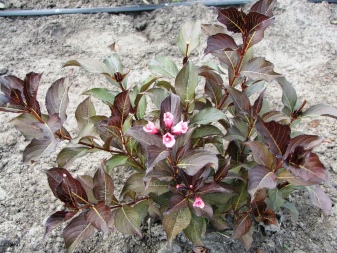
The open ground planting process is as follows.
- Dig a planting hole 60 cm deep.
- Lay a 15 cm drainage layer on the bottom, you can use gravel and sand.
- The next layer is a mixture of leafy earth, sand and compost.
- Remove the seedling from the container. Gently smooth out the root system and place in the hole so that the root collar is not buried.
- Cover the roots with soil.
- Moisten the planting site liberally.
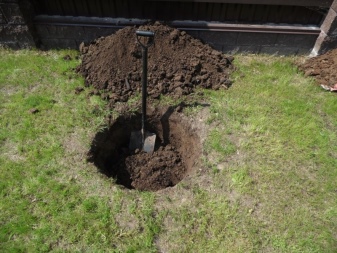
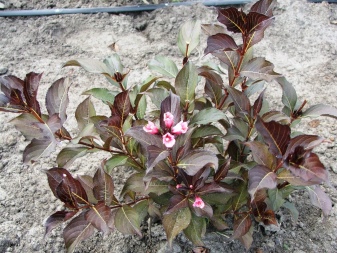
Using weigela in garden design
In the design of the garden, weigels are used in a variety of ways: these are clumps on the lawn, single plants on the edge or under sparsely standing trees with an openwork crown, undersized varieties are suitable for rocky areas, tall weigels are effective in hedges.
If you have about a dozen plants at your disposal, then they can be placed in the form of one or three groups, depending on the species or varietal diversity and compositional solution of the site. In one group, it is recommended to plant 3-5 specimens, picturesquely placing them on the lawn. A group should consist of plants of the same species or variety, harmoniously combined in color of flowers, in shape and size of bushes, in terms of flowering.
It is recommended for plants planted in groups to arrange a common near-stem circle, which must be mulched. If the group is loose, then the space between the bushes of weigels is planted with perennials: hosta, astilbe, ferns, which will decorate the garden throughout the summer.
Mixed plantings combine weigels with other shrubs, for example, low-growing barberries, cotoneaster, Vangutta and Argut spireas, Japanese quince, Buldenezh viburnum, as well as among conifers - junipers, cypress trees and others. Single specimens of weigela are spectacular on the parterre lawns at the front entrance to the house or at the gate.
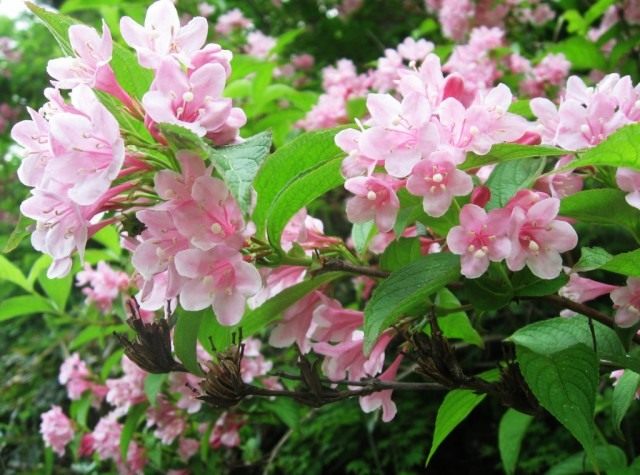 Weigela garden (Weigela hortensis). Qwert1234
Weigela garden (Weigela hortensis). Qwert1234
Reproduction methods
Weigela can be propagated by seeds, cuttings and layering.
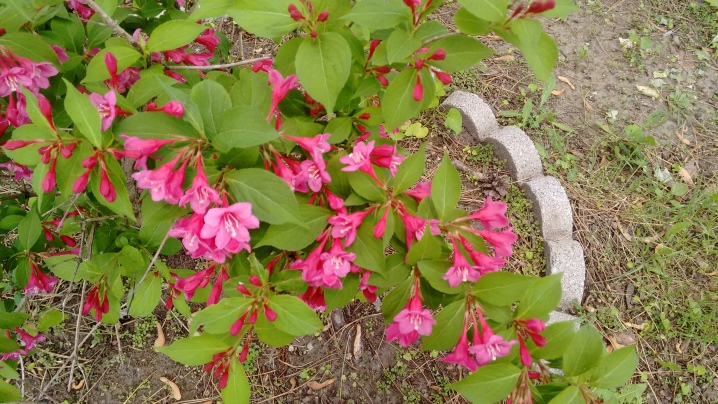
Cuttings
It is possible to grow a shrub that has retained all its maternal qualities by cuttings. It can be done 2 times a season: before the buds open (in March) and in early June. In spring it is done like this.
- Woody twigs are cut off and divided into cuttings, their length is from 10 to 15 cm. Each stalk must have at least 2 buds.
- The leaves are removed from the bottom of the cutting, and the upper ones are cut off to half the length.
- The cuttings are placed for a few minutes in a root growth stimulator (Kornevin, Epin).
- Then they are planted in a container with a substrate consisting of turf soil and sand, taken in equal quantities, deepening by about 0.5-1 cm, and then covered with a film.
- Caring for seedlings consists of regular watering, feeding and daily airing.
- Pinching is carried out on a seedling that has reached a height of 5 cm.

Over the summer, seedlings usually grow up to 25 cm. They need to be transplanted into a separate container and grown at home a year until next fall. During this time, a young bush grows up to 4 shoots. Such a seedling must be transplanted into open soil. In summer, cuttings of green twigs are used. They are prepared for planting in the same way as for spring cuttings. However, the planting of green cuttings is done directly in the ground. They should be covered with a jar, which is removed every day for airing. Watering is carried out daily.
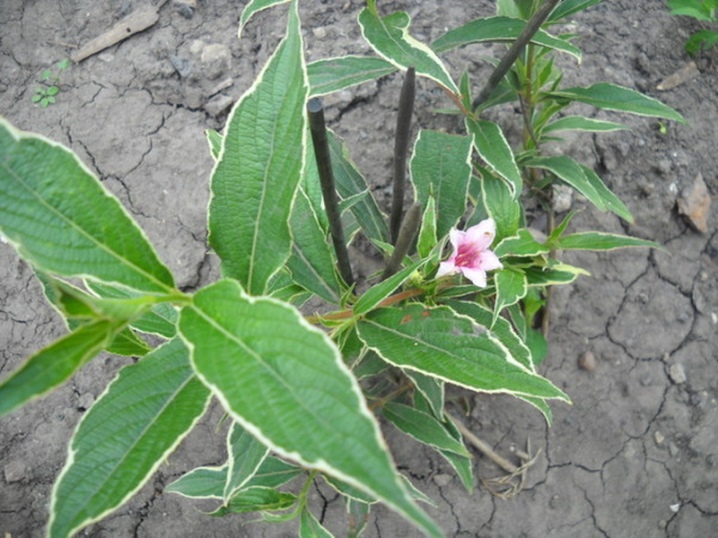
Layers
For layering, choose a healthy, strong lower branch and tilt it towards the soil. In those places where the shoot touches the ground, you need to make an incision in the bark. The branch is attached to the ground and covered with soil. In spring, the layering gives roots and shoots. They can be transplanted to a permanent place only at the age of 3.
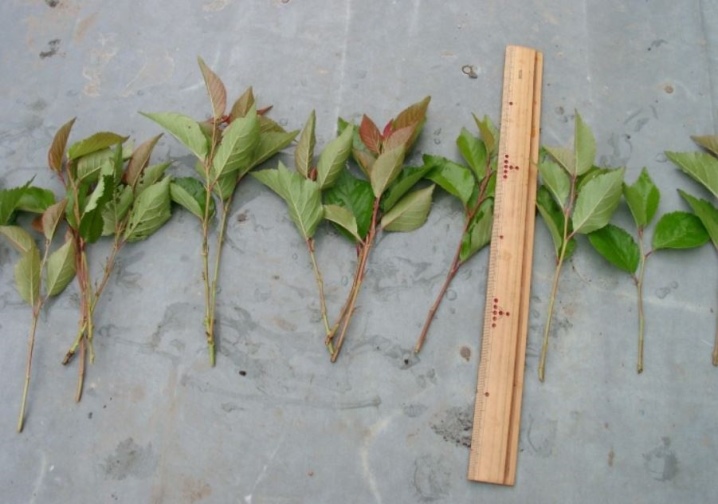
Seeds
With the seed method, the so-called self-seeding is usually used: seeds that have fallen into the ground in the spring can germinate. Of these, the strongest are chosen and the houses are grown for 2 years and only then are they planted in a permanent place.
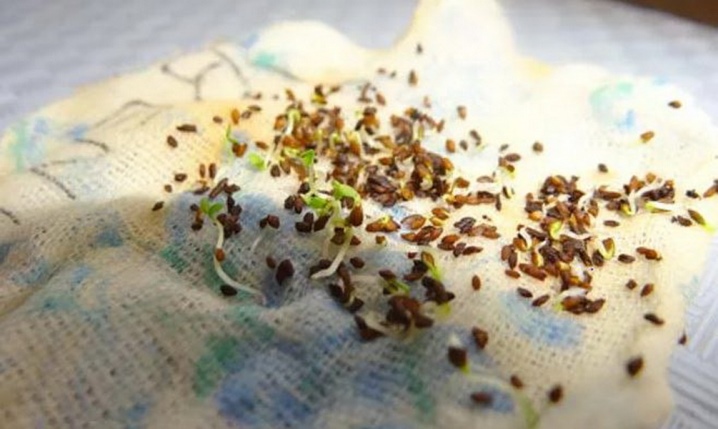
Reproduction
Seeds
When weigela is propagated by seeds, their germination lasts about a year. Lovers breed weigela at home in flower pots under glass or foil. A one-year-old weigela seedling has a length of 6 cm, a two-year-old 0.5 m. After the appearance of true leaves, the seedlings dive. Weigela needs to be grown in the summer at their summer cottage.

The plant has a fibrous root system and spreads rapidly underground. Varieties are best propagated vegetatively. Cuttings are carried out in the first half of summer before flowering.

Weigela, propagated by cuttings in summer, blooms after 2 years of age. How is grafting carried out?


Summer cuttings
- Step 1 Weigela leaves are removed half or completely.
- Step 2. The cuttings are placed in water for several hours, dipped in the root, and kept for half a day in a dark room.
- Step 3. Planting of plant cuttings is carried out in the second half of June. The soil should include sand and peat. The weigela stalk should be in the ground at a depth of about 1 cm. The young stalk is covered and watered several times a day.

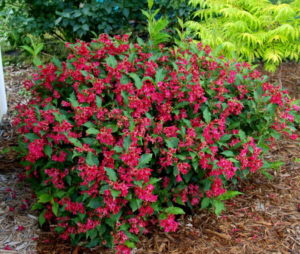
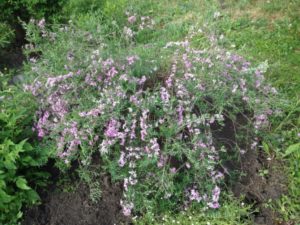
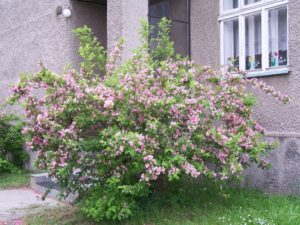
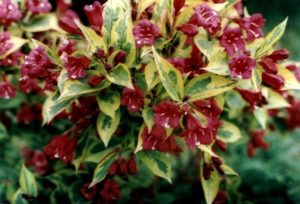
Winter cuttings
Cuttings, 20 cm long, are also cut in April before the leaves open.

- Step 1. Peat and sand are poured into the pots in a 1: 1 ratio. The planting material is treated with root roots.
- Step 2. After a month, pinching is done, and top dressing is applied.


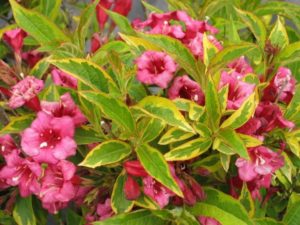

Winter cuttings are not as effective as summer cuttings.



